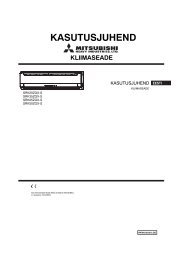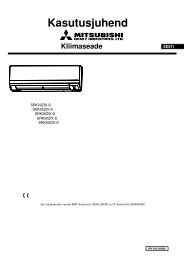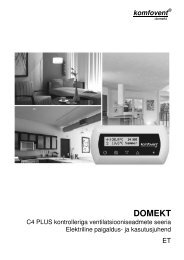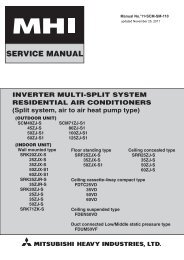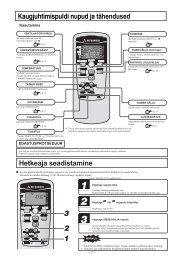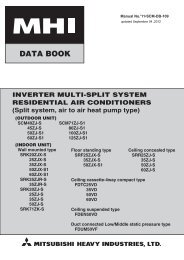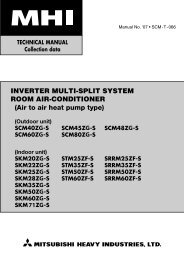TECHNICAL MANUAL - BVT Partners OÃ
TECHNICAL MANUAL - BVT Partners OÃ
TECHNICAL MANUAL - BVT Partners OÃ
- No tags were found...
Create successful ePaper yourself
Turn your PDF publications into a flip-book with our unique Google optimized e-Paper software.
2. REFRIGERANT PIPING WORK1) Restrictions on unit installation and use• Check the following points in light of the indoor unit specifications and the installation site.• Observe the following restrictions on unit installation and use. Improper installation can result in a compressor failure or performance degradation.Elevation difference betweenindoor and outdoor unitsRestrictionsMain pipe lengthCAUTION2) Determination of pipe sizeWhen the outdoor unit is positioned higher,When the outdoor unit is positioned lower,The use restrictions appearing in the table above are applicable to the standard pipe size combinations shown in the table below.Determine refrigerant pipe size pursuant to the following guidelines basedon the indoor unit specifications.Outdoor unit connectedRefrigerant piping (branch pipe L)Gas pipeø15.88Flareø15.88Liquid pipeø6.35Flareø6.35Dimensional restrictions30m or less20m or less20m or lessAbout brazingMarks appearing in thedrawing on the rightWhen pipe is brazing.LHHBrazing must be performed under a nitrogen gas flow.Without nitrogen gas, a large quantity of foreign matters(oxidized film) are created, causing a critical failure fromcapillary tube or expansion valve clogging.NitrogenHOutdoor unitPlug the end of the pipe with tape, or othermaterial, and fill the pipe with nitrogen gas.TapingOnly use nitrogen gas (N2)BrazingPrimary sideStation valveNitrogengasRelief valveIndoor unitSecondary side0.5MPaHandLIndoor unit connectedø15.88ø6.353) Refrigerant pipe wall thickness and material• Select refrigerant pipes of the table shown on the right wall thickness andmaterial as specified for each pipe size.NOTESelect pipes having a wall thickness larger than the specifiedminimum pipe thickness.4) On-site piping workPipe diameter [mm]Minimum pipe wall thickness [mm]Pipe material*ø6.35*Phosphorus deoxidized seamless copper pipe ICS 23.040.15, ICS 77.150.300.8O-type pipeø15.881.0O-type pipeIMPORTANTTake care so that installed pipes may not touch components within a unit.If touching with an internal component, it will generate abnormal sounds and/or vibrations.APlease remove the screw of a side cover andHow to remove the side coverremove to the front.• Carry out the on site piping work with the operation valve fully closed.• Give sufficient protection to a pipe end (compressed and blazed, or with anadhesive tape) so that water or foreign matters may not enter the piping.• Bend a pipe to a radius as large as practical (R100~R150). Do not bend a piperepeatedly to correct its form.• Flare connection is used between the unit and refrigerant pipe. Flare a pipe afterengaging a flare nut onto it. Flare dimensions for R410A are different fromthose for conventional R407C. Although we recommend the use of flaring toolsdesigned specifically for R410A, conventional flaring tools can also be used byadjusting the measurement of protrusion B with a protrusion control gauge.• The pipe should be anchored every 1.5m or less to isolate the vibration.• Tighten a flare joint securely.ScrewSide coverBFlared pipe end : A (mm)Copper pipeouter diameterø6.35ø15.88Copper pipeouter diameterø6.35ø15.880A –049.119.7Copper pipe protrusion for flaring : B0~ 0.5 1.0~ 1.5(mm)In the case of a rigid (clutch) typeWith an R410A tool With a conventional tool- 35 - '11 • SRK-T-105CAUTIONDo not apply force beyond proper fastening torque in tightening the flare nut.Fix both liquid and gas operation valves at the valve main bodies as illustrated on the right, and then fasten them,applying appropriate fastening torque.Operation valve size (mm)ø6.35 (1/4")ø15.88 (5/8")Tightening torque (N·m)14~ 1868~ 82Tightening angle ( )45~ 6015~ 20Recommended length of a tool handle (mm)150300Do not hold the valve cap area with a spanner.Use a torque wrench. If a torque wrench is notavailable, fasten the flare nut manually first and thentighten it further, using the left table as a guide.




